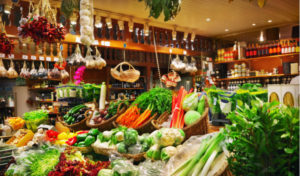
Image used under license from Shutterstock.com
Most grocery stores are set up in more or less the same way. Aisles and aisles of refined carbohydrates stacked in the middle, surrounded by produce on one side, meat in the back, and dairy on the other. On the ends of each aisle are high calorie impulse purchases tempting shoppers who must pass by to get to the healthier options. Online sales may break this time-tested model.
Online shoppers are less likely to want impulse foods because they have more time to consider their options and plan ahead. In response to online shopping behavior, at least one store chain, Smart & Final, is altering the layout of its stores to better serve those shoppers. Heather Haddon reports in The Wall Street Journal:
Smart & Final Inc. has made some changes lately that would seem like near-heresy for a supermarket: The California-based chain ripped out racks of snacks and other profitable impulse purchases near the doors of some stores and instead installed freezers there.
But grocery executives say the seemingly irrational move is simply one of many signs that the supermarket business is radically changing. The freezers will serve as pickup points for customers who order their groceries online and may never go any farther into the store.
Such online sales, says Smart and Final Chief Executive David Hirz, is “becoming a meaningful piece of our business.”
After years of inertia, U.S. supermarket chains are racing to add online options, such as home delivery and in-store and curbside pickup, to keep shoppers from shifting more of the $800 billion in annual food and beverage spending to e-commerce firms such as Amazon.com Inc. The process is spurring retailers and major food brands to change fundamental aspects of their operations—from staffing and supply networks to the way they organize their parking lots and stores. At the same time, the online shift has created complications for the physical stores.
Bill Bishop, co-founder of consulting firm Brick Meets Click, calls it the biggest change to supermarket operations since the introduction of bar codes to consumers goods. “There really hasn’t been anything this sweeping operationally since,” Mr. Bishop says.
Read more here.
